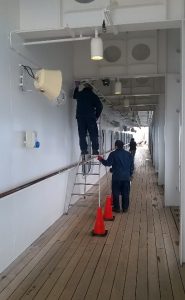The Charity
Aviation
Maritime
Passenger Vessel Safety (1)

Initial Report
This report should be read in conjunction with “Passenger Vessel Safety (2) and (3)”
Outline:
CHIRP has received several reports regarding both domestic and international passenger vessels outlining failings in safety management.
What the Reporter told us (1):
I was on a cruise earlier this year. As an ex-mariner I was shocked by the occasional unseamanlike behaviour of the deck crew. The following was noted – small things possibly, but indicative of the culture on board. I contacted the onboard ship management but their response was less than helpful so I wrote to the company. Their comments are in italics.
- Mooring crew left a stairwell gate swinging even though it had a securing device. The next six crew-members who went through that gate left it open, swinging They all knew the vessel was proceeding to sea
- Personnel painting cable runs in the deck-head. On one occasion a safety harness was worn but was not used, the second time, a safety harness was not The photograph shows the crew member up a ladder and being supported below by another crew member. Whilst the Code of Safe Working Practices does allow for this control measure to be used, this is still ‘working at height’. The Code lists the control measures that should be in place and the approved onboard risk assessment allows for ladder use in such a reduced height task such as this. Note the ladder is supported below. In this instance the practicality of securing a safety harness in a confined place such as this would have likely been more hazardous than the fall.
- I watched an AB sharpening his scraper with a disc The disc was facing upwards and turning whilst he laid the scraper on it. Guests were walking past while this was going on but rather than go down to a workshop, put the scraper in a vice and do it properly, he put himself and passengers at risk. This was likely very isolated and will be brought up at toolbox talks with the deck crew to ensure power tools are used safely.

Painting aloft – how secure is your ladder and what are the consequences of you falling?
CHIRP Comment:
The Maritime Advisory Board commented that in both reports, [Editorial Note: – see Passenger Vessel Safety (2)] the hazards do not appear to have been managed, indicating a poor level of safety culture and leadership. It was questioned whether the “two metre rule” is detracting from the use of a permit to work (which should take into account the specific location of the work, and potential hazards). CSWP Chapters 8, 11, 17 refer. MAIB have investigated several fatalities caused by falls from height, whilst MARS and CHIRP both have reports related to working aloft, so the issue still requires close attention.
Report Ends.







